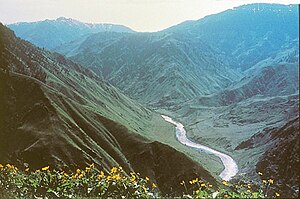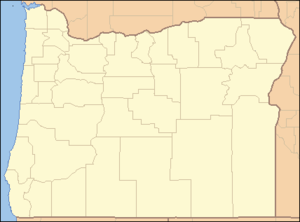Hells Canyon
| Hells Canyon | |
|
Snake River flowing through the canyon
|
|
| Country | United States |
|---|---|
| States | Oregon, Idaho |
| County | Wallowa County, Oregon, Adams County, Idaho, Idaho County, Idaho |
| Source | Snake River |
| - location | near river mile (RM) 254, Wallowa and Adams counties |
| - elevation | 1,688 ft (515 m) |
| - coordinates | 45°09′37″N 116°43′29″W / 45.16028°N 116.72472°W |
| Mouth | Snake River |
| - location | near RM 238, Wallowa and Idaho counties |
| - elevation | 1,384 ft (422 m) |
| - coordinates | 45°22′17″N 116°38′18″W / 45.37139°N 116.63833°WCoordinates: 45°22′17″N 116°38′18″W / 45.37139°N 116.63833°W |
Hells Canyon is a 10-mile (16 km) wide canyon located along the border of eastern Oregon, eastern Washington and western Idaho in the United States. It is part of the Hells Canyon National Recreation Area and is North America's deepest river gorge at 7,993 feet (2,436 m).
The canyon was carved by the waters of the Snake River, which flows more than 1 mile (1.6 km) below the canyon's west rim on the Oregon side and 7,400 feet (2,300 m) below the peaks of Idaho's Seven Devils Mountains range to the east. Most of the area is inaccessible by road.
The geologic history of the rocks of Hells Canyon began 300 million years ago with an arc of volcanoes that emerged from the waters of the Pacific Ocean. Over millions of years, the volcanoes subsided and limestone built up on the underwater platforms. The basins between them were filled with sedimentary rock. Between 130 and 17 million years ago, the ocean plate carrying the volcanoes collided with and became part of the North American continent. A period of volcanic activity followed, and much of the area was covered with floods of basalt lava, which smoothed the topography into a high plateau. The Snake River began carving Hells Canyon out of the plateau about 6 million years ago. Significant canyon-shaping events occurred as recently as 15,000 years ago during a massive outburst flood from Glacial Lake Bonneville in Utah.
The earliest known settlers in Hells Canyon were the Nez Percé tribe. Others tribes visiting the area were the Shoshone-Bannock, northern Paiute and Cayuse Indians. The mild winters, and ample plant and wildlife attracted human habitation. Pictographs and petroglyphs on the walls of the canyon are a record of the Indian settlements.
...
Wikipedia


